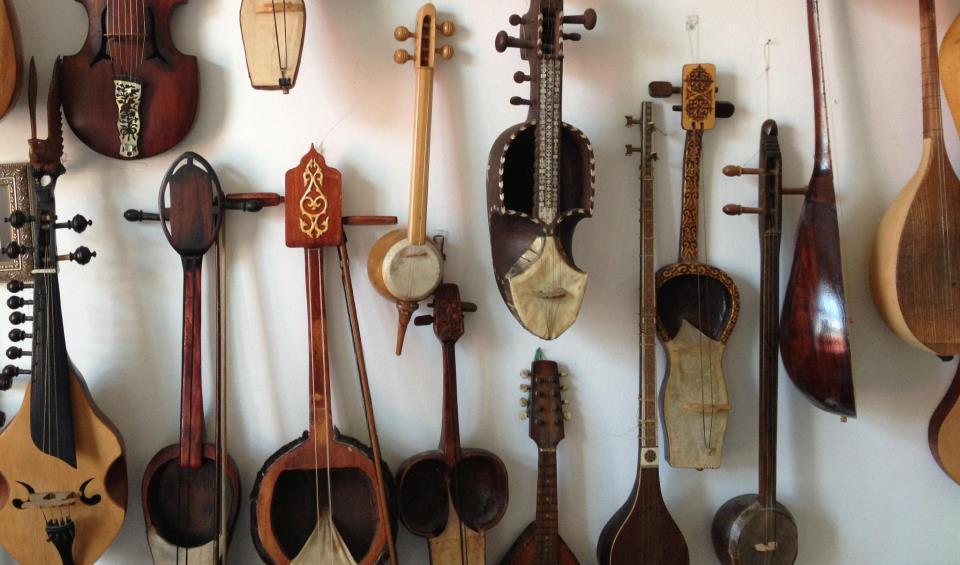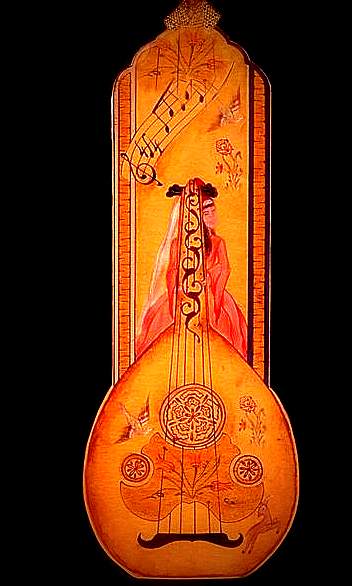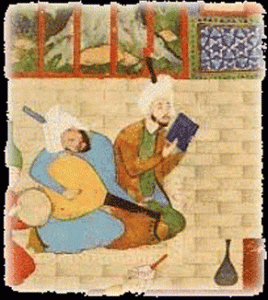The oud (/uːd/; Arabic: عود ʿūd Arabic pronunciation: [ʕu(ː)d, ʢuːd], plural: أعواد aʿwād; Armenian: ուդ, Assyrian: ܥܘܕ ūd, Greek: ούτι oúti; Hebrew: עוּד ud; Persian: بربطbarbat; Kurdish: ûd; Turkish: ud or ut;[1] Azeri: ud; Somali: cuud or kaban) is a pear-shaped stringed instrument commonly used in Arabic, Greek, Turkish, Persian,Jewish, Byzantine, Azerbaijanian, Armenian, North African (Chaabi, Classical, and Spanish Andalusian), Somali and Middle Eastern music. Construction of the oud is similar to that of the lute.[2] The modern oud and the European lute both descend from a common ancestor via diverging paths. The oud is readily distinguished from the lute by its lack of frets and smaller neck. Alongside the lute, it is considered an ancestor of the guitar.[3]
The origin of the name oud (and its etymological cousin, lute) for the musical instrument is uncertain. The Arabic: العود (al-ʿūd) literally denotes a thin piece of wood similar to the shape of a straw. It may refer to the wooden plectrum traditionally used for playing the oud, to the thin strips of wood used for the back, or to the wooden soundboard that distinguished it from similar instruments with skin-faced bodies.[4] Research by Eckhard Neubauer suggests that oud may simply be an Arabic borrowing from the Persian word rōd or rūd, which meant string, stringed instrument, or lute.[5][6]
Modern-day ouds fall into two categories: Arabic and Turkish. This distinction is not based solely on geography since Turkish ouds can also be found in Greece and occasionally other parts of the Mediterranean, whereas Arabic ouds can be found in various locations all over the Arab world. The Arabic ouds, such as the Iraqi oud, Egyptian oud and Syrian oud, are normally grouped under the term ‘Arabic oud’ because of their similarities.[10]
Arabic ouds are normally larger than their Turkish counterpart, producing a fuller, deeper sound, whereas the sound of the Turkish oud is more taut and shrill, not least because the Turkish oud is tuned one whole step higher than the Arabic. Turkish ouds tend to be more lightly constructed than Arabic with an unfinished sound board, lower string action and with string courses placed closer together. Arabic ouds have a scale length of between 61cm and 62cm in comparison to the 58.5cm scale length for Turkish. [11]
FAMED OUD PLAYERS
Turkish:
Serif Muhiddin Targan
Mutlu Torun
Necati Çelik
Yurdal Tokcan
Münir Nurettin Beken
Vedat Gençtürk
Halil Aksoy
Sedat Oytun
Mehmet Emin Bitmez
Samim Karaca
Osman Nuri Özpekel
Yilmaz Yüksel
Coskun Sabah
Bayram Coskuner
Armenian:
Udi Hrant Kenkulian
John Bilezikjian
H. Aram Gulezian
Ara Dinkjian
John Berberian
Richard A. Hagopian
Haig Manoukian
Arab:Anouar Brahem
Farid al-Atrash
Munir Bashir
Omar Bashir
Simon Shaheen
Asim al-Chalabi
Hamza el-Din
Driss el-Maloumi
Ahmed Mukhtar
Majid Nazempour
Haytham Safia
Adel Salameh
Naseer Shamma
Joseph Tawadros
Riyad is-Sinbati
Husain Sabsaby
Greek:Yorgo Bacanos
Antonis Apergis
Nikos Dimitriades
Mavrothis Kontanis
Israeli:Yair Dalal
OUD LUTHIERS
Dincer Dalkilic (USA/Turkey)
Faik Mohammad Fadel (Iraq)
Nazih Ghadban (Lebanon)
Viken Najarian (USA)
Dimitris Rapakousios (Greece)
Ramazan Calay (Turkey)
Cengiz Sarikus (Turkey)
Tasos Theodorakis (Greece)
Faruk Turunz (Turkey)
Feridun Obul(Turkey)
Mustafa Copcuoglu (Turkey)
Ali Nisadir
Mehmet Caymaz





